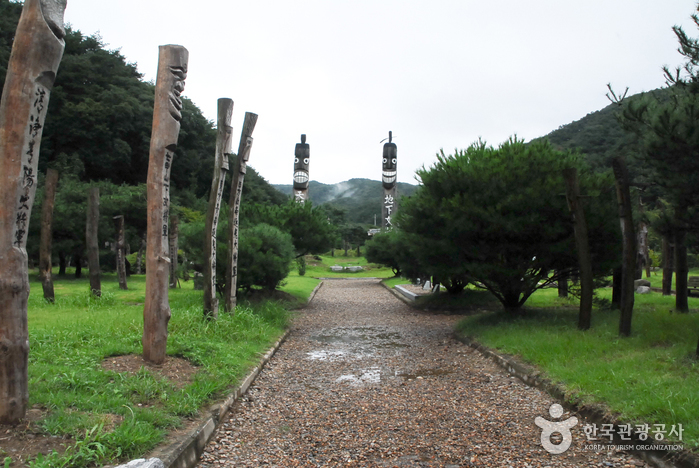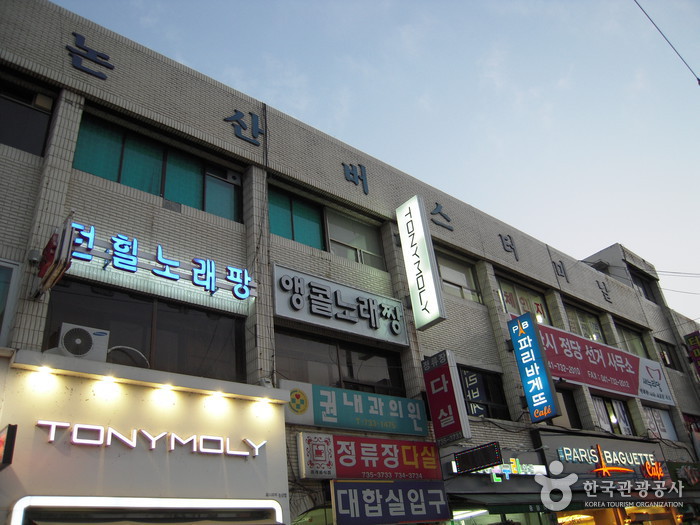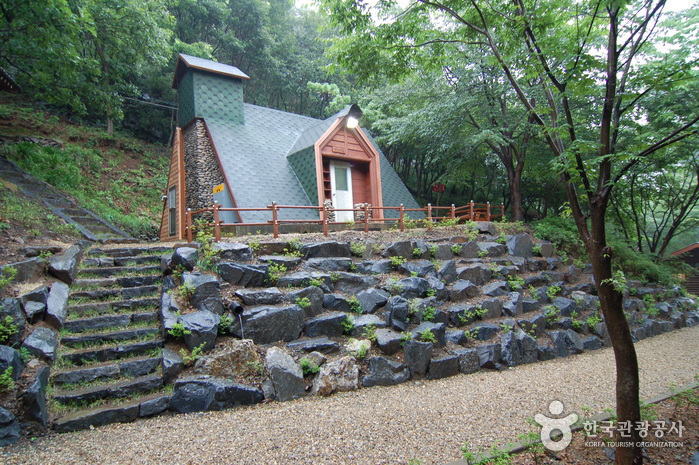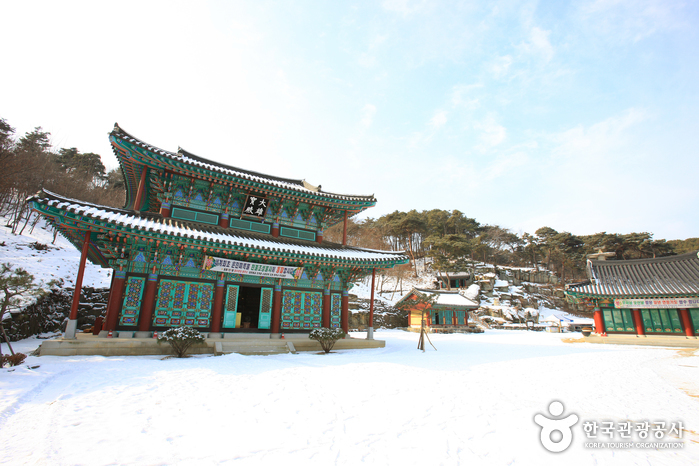Festival des fraises de Nonsan (논산 딸기축제)
16.4 Km 2998 2020-04-22
319-10, Daegyo-dong, Nonsan-si, Chungcheongnam-do
- Ligne Info Toursime +82-41-1330 (coréen, anglais, japonais, chinois)
Nonsan est la plus grande région productrice de fraise en Corée. Chaque année au mois d’avril s'y tient un festival mettant à l'honneur ce fruit plein de vitamine C. L’évènement qui attire de plus en plus l’attention des Coréens comme des étrangers, aura lieu cette année du 4 au 8 avril. Les fraises de Nonsan sont réputées pour leur goût et leur qualité. Les visiteurs pourront en cueillir autant que leur panier, ou leur estomac, puisse en contenir. Se tiendront également une exposition sur les fraises et beaucoup d'autres ateliers participatifs tels que celui sur la préparation d'un gâteau au fraise et de la confiture de fraise.
Parc des Jangseung au mont Chilgapsan (칠갑산 장승공원)
16.5 Km 4791 2021-08-04
Janggok-ri, Daechi-myeon, Cheongyang-gun, Chungcheongnam-do
+82-41-940-2722
Le parc des jangseung sur la montagne de Chilgapsan est la plus grande zone de préservation des jangseung, les anciens totems de bois ou de pierre habituellement placés à l’entrée des villages pour chasser les mauvais esprits. Le parc a été établi en mai 1999 afin de favoriser la prise de conscience à propos de ces artefacts, et d’abriter les plus hauts jangseung de Corée (11,5 m) ainsi que des répliques de totems indigènes du monde entier. Aujourd’hui, on y organise toujours le festival annuel des jangseung du mont Chilgap, et c’est un site important découvrir l’histoire coréenne.
Terminal de Bus Express Nonsan
17.0 Km 4357 2020-05-18
599-3 Chwiam-dong Nonsan-si Chungcheongnam-do
+82-41-735-3677
Terminal des bus interurbains de Nonsan
17.2 Km 6711 2015-11-09
1045-1 Chwiam-dong Nonsan-si Chungcheongnam-do
Bonsuwon Wangsutbulgalbi (수원갈비)
17.3 Km 521 2016-09-05
7-4, Jungang-ro 410beon-gil, Nonsan-si, Chungcheongnam-do
This restaurant is located at Meokjagolmok which is on the right side of Nonsan a cross-country bus terminal .Because it is built of wood and yellow earth, the inside is so warm and makes a traditional atmosphere. This restaurant accommodates 120 patrons and the kitchen and restroom are kept clean. All employee offer high quality service. Most of all , we can enjoy the abundant side dishes there.
La Forêt Chilgapsan (칠갑산자연휴양림)
19.0 Km 17709 2021-01-20
668-103, Chilgapsal-ro, Daechi-myeon, Cheongyang-gun, Chungcheongnam-do
+82-41-940-2428
La forêt Chilgapsan est située dans la partie ouest du parc r’egional Chilgapsan, qui est surnomé comme « les Alpes » de Chungcheongnam. La forêt abrite une variété d'installations, y compris des chalets, un centre de formation, des maisons traditionnelles coréennes, des salles de réunion, des installations sportives, un parc aquatique ainsi qu'un observatoire. Le site dispose également d'un domaine d'éducation sur la nature et des jeux pour les enfants. Les attractions touristiques à proximité comprennent le temple Janggoksa, la vallée Naengcheon, le lac Cheonjang, la rivière Gugokjicheon et le temple Modeoksa.
Maison Myeongjae[Korea Quality] (논산 명재고택 [한국관광 품질인증])
19.4 Km 10549 2023-04-13
50, Noseongsanseong-gil, Noseong-myeon, Nonsan-si, Chungcheongnam-do
+82-41-735-1215, +82-10-6310-1139
Located in Noseong-myeon, Nonsan-si, Chungcheongnam-do, Myeongjae Historic House was built by Yun Jeung (pen-name: Myeongjae, 1629-1714), a scholar during the reign of King Sukjong (r. 1674-1720) of the Joseon Dynasty. It is said that although the king granted him a government post on eighteen occasions, Yun, being a straightforward sort of person, declined them all. As he practiced the virtue of simplicity and sharing in life and taught it to younger generations, the house escaped destruction during the Donghak Peasant Revolution (1894) and the Korean War (1950-1953) thanks to the efforts of his disciples. Thus, in keeping with his character, the house looks moderate compared to the homes of other aristocrats, although it exhibits a refined interior and a scientific design. The house consists of a sarangchae (men’s quarters), anchae (women’s quarters), and daecheongmaru (main floored room) configured in a square layout. The sarangchae itself consists of the keun sarangbang (large room) flanked by a daecheong and a numaru with an open view of the village and a mountain, the jakeun sarangbang (small room), the ansarangbang (inner room), and the daemungan (gate). To the right of the house is the spectacular sight created by a platform filled with hundreds of crocks for traditional sauces and condiments. The wall situated between the sarangchae and the anchae was designed to prevent people from looking into the anchae. There is also an open space below the wall from which one could see the shoes of a visitor, thus enabling the occupants of the anchae to know whether there was a visitor or not in the sarangchae. In addition, the gotganchae (storage quarters) situated next to the anchae is designed in such a way that it diminishes in size towards the north because the summer wind blowing from the south escapes the narrow passageway of the north, so it blows faster and the surrounding area gets colder, while the wind winter blowing from the north escapes the large passageway of the south, protecting the building from the bitter wind of the north. Therefore, the storeroom at the north end of the gotganchae remains cool even in summer, thereby preserving the things (food and other commodities) stored there. The guestrooms of the house include the three sarangbang rooms in the sarangchae building and the geonneonbang (a room opposite the main living room) in the anchae. The entire sarangchae building including the numaru can be rented too. Guests can also rent the thatched-roof byeolchae in the courtyard, which features a choyeondang equipped with a sound system and a beam projector, as well as a modern bathroom, for group meetings or performances. The house also runs a variety of paid traditional experience programs including Gukak (Korean classical music), tea ceremony, natural dyeing, and so on. Other noteworthy features of the house include the sarangchae’s distinctive gate, which combines a sliding door with a hinged door, the looming presence of a mountain to its rear, and the little round island (pond) planted with an old crape myrtle at its front.
Temple Gwanchoksa à Nonsan (관촉사(논산))
19.9 Km 7592 2020-04-22
25, Gwanchok-ro 1beon-gil, Nonsan-si, Chungcheongnam-do
+82-41-736-5700
Le temple Gwanchoksa (관촉사) à Nonsan, Chungcheongnam-do est situé au pied du mont Banyasan (à 100 mètres d’altitude). Ce temple conserve un Bouddha Seokjomireukbosalipsang (Trésors No. 218), qui a été construit pendant 38 ans, commençant en 967 durant la période Goryeo. Selon la légende, alors qu’une jeune femme ramassait des crosses de fougère sur le mont Banyasan, elle a entendu un bébé pleurer. Lorsqu’elle est allée à l’endroit d’où venaient les pleures, il n’y avait pas de bébé mais à la place un énorme rocher sortant du sol.
Après avoir entendu cette histoire, le gouvernement a commandé une statue de Bouddha faite de ce rocher. Cette statue de Bouddha est largement connue sous le nom de « Bouddha Eunjimireuk », est la plus grande statue de pierre de Bouddha en Corée (18,12 mètres de haut, 9,9 mètres de périmètre, 1,8 mètres de longueur au niveau des oreilles, 2,43 mètres de longueur au niveau du crâne). Il y a de nombreux autres héritages culturels dans ce temple et chaque mois d’avril est idéal pour voir un splendide tunnel de cerisiers en fleur qui s’étend entre Nonsan et le temple Gwanchoksa




![Maison Myeongjae[Korea Quality] (논산 명재고택 [한국관광 품질인증])](http://tong.visitkorea.or.kr/cms/resource/40/1878940_image2_1.jpg)

 Français
Français
 한국어
한국어 English
English 日本語
日本語 中文(简体)
中文(简体) Deutsch
Deutsch Español
Español Русский
Русский